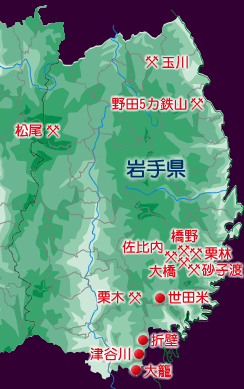
The iron and steel industry in the Kitakami Highlands seems to be old, but the situation until the middle ages is not well understood. When entering the Edo period, Sendai Ii-gun Oiwa-gun (now Fujisawa-cho), Ori-kabe, Tsuyagawa (Tsujigawa, both Ichinoseki-shi, Murone-cho), Seta of Kesen-gun Ironmaking is said to have begun in rice (Setamai, Sumita-cho). According to the legend, two people, Tosa and Tsushima, who had been enrolled in Binaka (Okayama Prefecture) Chiharu Daisukero and Korokuro, learned the technique and began steelmaking in Oiso. A record of having received 1,600 ss of iron in connection with Iwadeyama fortress of Date Masamune (1598), 20,000 s. Of iron in Sendai s Castle of 5 s. (1600), and 50,000 s. In s. You are There is a legend that a man named Sato Juro Saemon studied steelmaking in the Chugoku region and started steelmaking here in Keicho 10 (1605) in the horse mackerel (Magome, Motoyoshi-cho, Miyagi Prefecture) adjacent to Oiso .
At this time, it was said that at this time, iron and steel industry was established in Tanohata village, Fushiro village, Yamagata village (now Kakata city Yamagata-cho) and Onomura (now Yono-cho), and the Kudo-gun area prospered as a steel center I am In the 17th century, iron export to nearby Ryokubo, and when the latest technology was introduced from the Chugoku region in the middle of the 18th century and production increased, the Sendai route, Soma route (Fukushima Prefecture), using the East Coast Shipping. It has also been exported to remote areas such as Mito clan and Edo. By the late 18th century, the short transportation distance and cheap fares of the southern railways overcame competition with the Bicchu irons and grew to almost monopolize the East Pacific Pacific coast market. The iron industry in Sendai Kashiwa was mainly a part-time job with agriculture, while the iron industry in Morioka and Hachinohe Kashiwa is a year-round operation by specialists who are engaged in capital investment by local farmers and large-scale businesses. The abundant charcoal used is one of the reasons.
